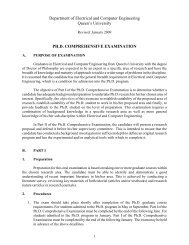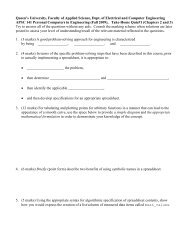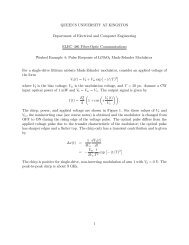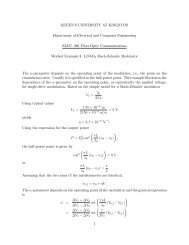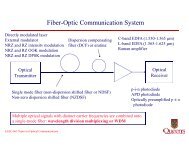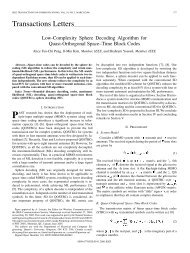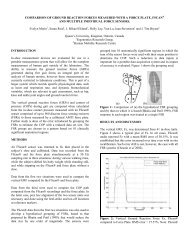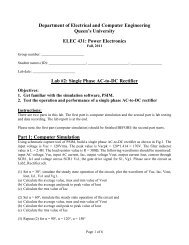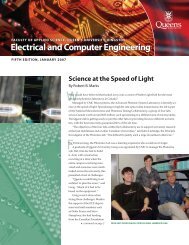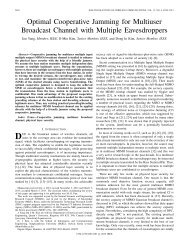Using Virtuoso Schematic Editor
Using Virtuoso Schematic Editor
Using Virtuoso Schematic Editor
You also want an ePaper? Increase the reach of your titles
YUMPU automatically turns print PDFs into web optimized ePapers that Google loves.
ELEC451 Integrated Circuit Engineering<strong>Using</strong> <strong>Virtuoso</strong> <strong>Schematic</strong> <strong>Editor</strong>Contents• 1. General• 2. Adding Components• 3. Connecting Components• 4. Selecting/Deselecting Components or Wires on the <strong>Schematic</strong>• 5. Adding Wire Names• 6. Editingo 6.1 Moving Components or Wireso 6.2 Deleting Components or Wireso 6.3 Undoing/Re-doing an Actiono 6.4 Editing Component Properties (Parameters)• 7. Printing a <strong>Schematic</strong>• 8. Saving a Design• 9. Creating a Symbol Cellview for Your Design1. General<strong>Virtuoso</strong> <strong>Schematic</strong> <strong>Editor</strong> is a schematic-entry tool. Is allows you to defineyour design in terms of a graphical picture of connected components (a"schematic'').All user designs, as well as components and cells prepackaged as part of theenvironment are stored in libraries, which are just Unix directories. Anycomponents you need are picked from these libraries.To start <strong>Schematic</strong> <strong>Editor</strong>, select File->Open from the icfb window menu. Nowchange the Library Name to the one you want, then click on the cell you want (ortype in its name), verify that the SCHEMATIC view of that cell is selected andclick OK. You can also use the Browse button to browse through the contents ofother libraries.What you really need to know about using <strong>Schematic</strong> <strong>Editor</strong> is covered inthe CAD assignments themselves, but for a better understanding, or as areference guide, please read the following sections.
2. Adding ComponentsYou can add one or more "instances'' of any component that you can find in alibrary. Use Add->Instance from the window menu. Like most actions, this onecan be taken either by selecting the menu item, selecting an icon from the toolbarat the left, or using an equivalent keyboard key (in this case the i key). The AddInstance dialog appears to allow you to locate the component you would like toadd, and you can then Browse different libraries to find it.Once you have clicked on a component, you can drag the mouse back into the<strong>Schematic</strong> <strong>Editor</strong> window, and a silhouette of the picked component follows,which you can then drop by clicking at the desired insertion point. Once you haveadded this first component, CDS is in the "add component'' mode, and isimmediately ready for you to drop in another one right away. If you only wantedthe one, you can click Cancel in the Add Instance dialog (or hit the ESC key onthe keyboard if that dialog box is not longer visible). If you want to add multiplebut different components, you do not need to close the Add Instance window, justclick on another component in one of the libraries to prepare to add it.3. Connecting ComponentsYou connect components with wires. Adding wires is part of the default mode forthe <strong>Schematic</strong> <strong>Editor</strong>, so you can just click on the terminal of one component(one of the little red boxes) to select it, drag the mouse to the terminal of thecomponent you want to connect to, and release to complete the wire. You canalso select Add->Wire from the <strong>Schematic</strong> <strong>Editor</strong> main menu, then click at thedesired endpoints. But if you type w as a shortcut, you have to have the mousealready positioned over the first terminal, or else you will end up with a wirehanging in space (hit Cancel or ESC to get out of that situation).4. Selecting/Deselecting Components or Wires onthe <strong>Schematic</strong>To select an existing wire or component on the schematic, left-click on it until yousee it highlighted with a solid box (or highlighted line for a wire). Note that adashed box (or a dashed line for wires) appears when you hover above acomponent (or wire), but you must then click to select it. If you fail to left-click atthis point, the "currently selected component'' (or wire) remains at the last oneyou clicked on. Remember this to avoid inadvertently modifying or deleting thewrong component or wire.To deselect a wire or component, click in an empty region of the schematic - thehighlighting of the wire or component will disappear to let you know it is no longerselected.
To select a group of adjacent components, click and drag to define an outline boxwith the mouse. When you release the mouse, all components and wires insidethe box are selected as a group.Personally, I recommend against selecting single objects by clicking onthem, since you then have to click in the empty background to deselectthem before moving on to a new object. Instead, I find it faster and moreconvenient to "hover" the mouse over the object of interest until its borderis dashed-highlighted, then use a keyboard key to take my desired action (m to move it, c to copy it, q to query/change it, and Del to delete it). You stillneed to hit ESC when done to get out of the mode for the last action youtook.5. Adding Wire NamesAlthough CDS generates automatically numbered "net'' names for each wire(circuit node), you can override these with explicit names that are moreinformative. Hover over the wire till it is dash-highlighted, then type the l key (for"label"), then type in the desired name, then click OK, and click the mouse on thewire to be named. You can also first click to select the wire, then use the Wire-Name toolbar tool, or the Add->Wire Name menu item.6. EditingYou can move, copy, delete, rotate, and take other actions on components fromthe Edit menu, but most of these have shortcut keys that are faster. The moreimportant edit actions are described below.6.1 Moving Components or WiresWith a single component or wire, you can just click and hold down the left mousebutton, and drag to the desired position - you don't need to select the component(or wire) first, and the action does not leave the component selected whencompleted. But to move a whole group of components to another spot, you firstneed to select that group by dragging a box around it, then move it to the newposition. To move the selected group (solid-white-highlighted), type the m key,then move your mouse (the group will follow), then click to drop it. You can onlymake a vertical OR a horizontal move at any one time. Be sure to deselect thegroup when done. You can also use the m key with single objects that you havefirst dash-highlighted by hovering over them with the mouse.
6.2 Deleting Components or WiresTo delete, hover over the component till it is dash-highlighted, then press the Delkey (this also works if you first click to select the component then use the DELkey or the Edit->Delete menu item, or the eraser icon at the left of the display.Caution: Once you delete an item, CDS is in the "delete'' mode, andanything you next click will also be deleted - to escape from this mode, hitthe ESC key as usual.6.3 Undoing/Re-doing an ActionYou can undo any change by typing in a u, clicking the undo icon, or using thecorresponding Edit menu item. You can actually undo a series of actions byrepeatedly typing u . The depth of this undo capability is set under Options->User Preferences in the icfb main window.If you accidentally undo something you didn't want undone, just do a "redo'' (typekey U (capital "U") or select it and use the Edit menu).6.4 Editing Component Properties (Parameters)Hover over the component to dash-highlight it, then type the q key (for "query") .Alternatively, you can select the component first by left-clicking on it, and thenuse either the q key, or click the Property icon on the toolbar, or select Edit->Properties. If you don't click to select the component first, you may end upinadvertently editing the properties of a different component - the component youhad last selected.From the Edit Properties window, you can change the values of the component'sparameters, for example, to change the voltage of a voltage supply, or to changethe width of a transistor, etc. The units for each property are defined by a letterwhich you are not allowed to change (even though it appears you can change it).For example, transistor dimensions are in metres (capital "M''), voltage sourcesare in volts (capital "V'') etc. The usual SI modifiers are accepted by typing themfollowing the numeric value you enter. For example, 3u means 3 x 10 -6 . Lettersm,u,n,p,f stand for milli, micro, nano, pico, and femto, respectively.Some properties are specified in terms of expressions involving variables orother property names. This allows, for example, a transistor width to be specifiedas a fixed multiple of its length, or instead to be specified by a variable whosevalue will be filled in later by the user during a simulation run.With CDS, the units are an integral part of the Property, so that when filling invariable values (for example, later on in a simulation), the unit must not be typed
in with the value of the variable. It is therefore incorrect to type in 3V for the valueof a voltage variable - CDS would interpret this to mean "3V" volts, which isundefined , rather than the "3" volts you intended.7. Printing a <strong>Schematic</strong>Select Design->Plot from the main <strong>Schematic</strong> <strong>Editor</strong> menu, and set up forprinting as described under "<strong>Using</strong> the Cadence Design System". You will needto click on the Plot Options button in the dialog box that appears in order tochoose the printer type, plus other options.8. Saving a DesignYou can save a design from the Design menu, but the Cadence documentationrecommends that you always use Check and Save rather than just Save. Youcan also save the design under a different name (for later editing to make adifferent version, say), but note that the current file name stays what it was. So ifyou want to save to a new name, and edit that newly-named design, you will firsthave to open it by using Design->Open. This behaviour is different from mosteditors and programs you may be used to, so be careful you are working on theproperly named schematic.9. Creating a Symbol Cellview for Your DesignYou can "package'' your designed cell into a convenient module that has agraphical symbol (a "symbol''), which allows you to then incorporate it as a wholeinto another design schematic. For example, you could package an inverterdesign schematic named, say inv_small, containing an NMOS and a PMOStransistor into a normal inverter symbol (i.e. a triangular package with one input,and one output, with a bubble at the output).Before you can make the symbol cellview, you need to add "pins'' (from the Addmenu, or by using the pin tool on the toolbar) to define where the inputs andoutputs are. Then when you select Design->Create Cellview->FromCellview, a cellview editor opens allowing you to define the shape of thesymbol that will house your design, labels, etc.Now you could open a new design, and by picking inv_small from your library,drop in an instance that would appear as the triangular inverter symbol, havingterminals to which you will connect. By using this feature, you can build updesigns hierarchically, with simple logic cells having few transistors at the bottomof the hierarchy, and complex cells ( that contain simpler lower-level cells) at thetop of the hierarchy. You should already be familiar with this approach if youhave used the Altera Design software.



